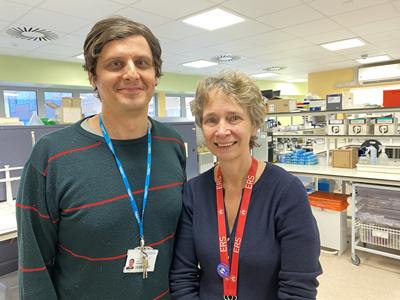‘Super res’ imaging and AI to improve lung disease diagnosis

Southampton researchers have developed a pioneering new way to detect a chronic lung disease that is notoriously difficult to diagnose.
Primary Ciliary Dyskinesia, or PCD, is a genetic condition that causes a persistent cough, blocked ears, continuous infections and the progressive degeneration of lung tissue, which can lead to transplant in some patients.
Vito Mennella, Associate Professor in Clinical and Experimental Sciences, is using a new type of 3D fluorescence microscopy, combined with machine learning, to improve the speed and accuracy of diagnosing the condition.
He said: “There is a portion of the population that is not diagnosed properly. The current diagnostic tests are not sensitive enough and only pick up 70 per cent of patients. Currently there is a lot of doctor hopping, and if people are not correctly diagnosed then the correct treatment is not given and patients’ lung health can degenerate faster.”
There is no cure for PCD, which affects one in 10,000 people. PCD is caused by defects in cilia, tiny structures covering the cells of the airway. Healthy cilia eliminate bacteria, viruses, mucus and allergens by moving them from the airways to the throat to be coughed up. In PCD, cilia don’t work properly. The condition is managed through rapid treatment of chest infections and twice daily airway clearance therapy, similar to that of Cystic Fibrosis patients. Children also need careful monitoring and treatment of hearing problems.
“Testing involves obtaining cells from a patient’s nose, which are labelled with fluorescent markers and assessed under a microscope,” said Professor Mennella. “This newly developed method improves the sensitivity of detection and automates diagnosis through images using machine learning algorithms.”
Jane Lucas, Professor of Paediatric Respiratory Medicine and head of the national NHS PCD centre in Southampton, explained how PCD usually presents: “Patients are born as healthy babies but within a few hours have respiratory problems. They often need to spend time on the neonatal unit and continue to have a daily wet cough throughout life. They have lots of chest infections and hearing problems. Infections commonly lead to irreversible lung damage.”
About half of PCD individuals’ organs are arranged in a mirror image, and about 10 per cent have complex heart problems.
Professor Lucas added: “This development is a big step forward. The standard NHS tests can diagnose about 70 per cent of people who have PCD. But there is a group of people we see who are highly likely to have PCD and we treat them as if they have, but we haven’t got a diagnostic test to confirm it. This will help to diagnose those people so they can be put onto the best treatment plan for them.”
Fiona Copeland, Chair of the PCD Family Support Group, said: “We’re very excited about this work. At the moment if you are tested for PCD it can take weeks or months to get the results, which often come back inconclusive. It’s a very worrying time for adults and parents when you know you or your child is not well and are struggling to get the correct diagnosis and treatment plan.
“We hope this new development will simplify PCD testing, reducing the time for results to be given to patients and generally improve the rates of diagnosis for this under-diagnosed condition.”
Professor Mennella’s research has been featured on the cover of Science Translational Medicine.